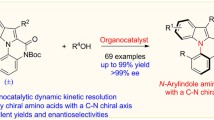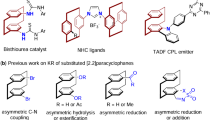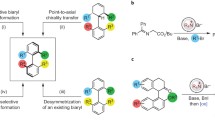Abstract
Efficient synthesis and resolution of a series of meta-substituted inherently chiral aminocalix[4]arene derivatives have been described. Consequently, the meta-nitro, bromo and chloro substituted inherently chiral calix[4]arenes could be directly synthesized by the nitration, bromination, and chlorination of the acylating product of aminocalix[4]arene. meta-Cyano and phenyl substituted inherently chiral aminocalix[4]arenes were readily obtained by the nucleophilic substitution reaction or Suzuki coupling reaction from the meta-bromo substituted one under the Pd-catalyzed conditions. For kinetic resolution of the racemic inherently chiral aminocalix[4]arenes, it was found that the electron-withdrawing ability of substituent was helpful to improving the resolution efficiency of the acylation process, and the kinetic resolution could be efficiently applied to the resolution of meta-nitro substituted inherently chiral aminocalix[4]arene, providing (cS)- or (cR)-isomer in up to 95% or 99.9% ee value, respectively, with the corresponding chiral acylating reagent. Moreover, by introduction of the chiral auxiliary, enantiopure antipodes of meta-cyano and phenyl substituted inherently chiral aminocalix[4]arenes could also be readily obtained. These enantiopure aminocalix[4]arenes are potential building blocks for constructing novel chiral receptors and asymmetric catalysts.
Similar content being viewed by others
References
Gutsche C D. Calixarenes revisited. In: Stoddart J F, ed. Monographs in Supramolecular Chemistry. London: Royal Society of Chemistry, 1998
Asfari Z, Böhmer V, Harrowfield J, et al. eds. Calixarenes 2001. Dordrecht, the Netherlands: Kluwer Academic Publishers, 2001
Kubo Y, Maeda S, Tokita S, et al. Colorimetric chiral recognition by a molecular sensor. Nature, 1996, 382: 522–524
Pinkhassik E, Stibor I, Casnati A, et al. Synthesis of upper and lower rim binaphthyl bridged calix[4]arenes: New potential chiral hosts for molecular recognition and catalysis. J Org Chem, 1997, 62: 8654–8659
Castellano R K, Nuckolls C, Rebek J Jr. Transfer of chiral information through molecular assembly. J Am Chem Soc, 1999, 121: 11156–11163
Zheng Y S, Zhang C. Exceptional chiral recognition of racemic carboxylic acids by calix[4]arenes bearing optically pure alpha,ss-amino alcohol groups. Org Lett, 2004, 6: 1189–1192
Cherenok S, Vovk A, Muravyova I, et al. Calix[4]arene alpha-aminophosphonic acids: Asymmetric synthesis and enantioselective inhibition of an alkaline phosphatase. Org Lett, 2006, 8: 549–552
Prins L J, Jolliffe K A, Hulst R, et al. Control of structural isomerism in noncovalent hydrogen-bonded assemblies using peripheral chiral information. J Am Chem Soc, 2000, 122: 3617–3627
No K H, Gutsche C D. Calixarenes 8. Short, stepwise synthesis of p-phenylcalix[4]arene, p-phenyl-p-tert-butylcalix[4]arene, and derived products. J Org Chem, 1982, 47: 2713–2719
Caccamese S, Notti A, Pappalardo S, et al. Inherently chiral alpha-picolyloxy-p-tert-butyl-calix[5]arene crown ethers: Synthesis, structure proof, and enantioselective HPLC resolution. Tetrahedron, 1999, 55: 5505–5514
Caccamese S, Bottino A, Cunsolo F, et al. Resolution of inherently chiral calix[4]arenes with AABB and CDCD substitution patterns on the upper and lower rims, respectively. Tetrahedron: Asymmetry, 2000, 11: 3103–3112
Hesek D, Inoue Y, Drew M G B, et al. Acid-promoted rearrangement of carbonate functionality anchored to the lower rim of a calix [4] arene skeleton: A new class of chiral calix[4]arene and its chiroptical properties. Org Lett, 2000, 2: 2237–2240
Shirakawa S, Kimura T, Murata S, et al. Synthesis and resolution of a multifunctional inherently chiral calyx [4] arene with an ABCD substi- tution pattern at the wide rim: The effect of a multifunctional structure in the organocatalyst on enantioselectivity in asymmetric reactions. J Org Chem, 2009, 74: 1288–1296
Cao Y D, Luo J, Zheng Q Y, et al. Preparation of both antipodes of enantiopure inherently chiral calix[4]crowns. J Org Chem, 2004, 69: 206–208
Luo J, Zheng Q Y, Chen C F, et al. Synthesis and optical resolution of a series of inherently chiral calix[4]crowns with cone and partial cone conformations. Chem Eur J, 2005, 11: 5917–5928
Mao R, Zheng Q Y, Chen C F, et al. Efficient syntheses and resolutions of inherently chiral calix[4]quinolines in the cone and partial-cone conformation. J Org Chem, 2005, 70: 7662–7671
Luo J, Zheng Q Y, Chen C F, et al. Facile synthesis and optical resolution of inherently chiral fluorescent calix[4]crowns: Enantioselective recognition towards chiral leucinol. Tetrahedron, 2005, 61: 8517–8528
Li S Y, Zheng Q Y, Chen C F, et al. Preparation of enantiopure inherently chiral calix[5]arenes. Tetrahedron: Asymmetry, 2005, 16: 641–645
Narumi F, Yamabuki W, Hattori T, et al. Synthesis and optical resolution of an anti-O,O′-dialkylated calix[4]arene. Chem Lett, 2003, 32: 320–321
Narumi F, Hattori T, Yamabuki W, et al. Resolution of inherently chiral anti-O, O′-dialkylated calix[4]arenes and determination of their absolute stereochemistries by CD and X-ray methods. Tetrahedron: Asymmetry, 2005, 16: 793–800
Narumi F, Hattori T, Matsumura N, et al. Synthesis of an inherently chiral O, O′-bridged thiacalix[4]crowncarboxylic acid and its application to a chiral solvating agent. Tetrahedron, 2004, 60: 7827–7833
Boyko V I, Shivanyuk A, Pyrozhenko V V, et al. A stereoselective synthesis of asymmetrically substituted calyx [4] arene-carbamates. Tetrahedron Lett, 2006, 47: 7775–7778
Yakovenko A V, Boyko V I, Danylyuk O, et al. Diastereoselective lower rim (1S)-camphorsulfonylation as the shortest way to the inherently chiral calix[4]arene. Org Lett, 2007, 9: 1183–1185
Shirakawa S, Moriyama A, Shimizu S. Design of a novel inherently chiral calix[4]arene for chiral molecular recognition. Org Lett, 2007, 9: 3117–3119
Shirakawa S, Kimura T, Murata S, et al. Synthesis and resolution of a multifunctional inherently chiral calix[4]arene with an ABCD substitution pattern at the wide rim: The effect of a multifunctional structure in the organocatalyst on enantioselectivity in asymmetric reactions. J Org Chem, 2009, 74: 1288–1296
Xu Z X, Zhang C, Zheng Q Y, et al. A new approach to enantiopure inherently chiral calix[4]arenes: Determination of their absolute configurations. Org Lett, 2007, 9: 4447–4450
Xu Z X, Zhang C, Yang Y, et al. Effective nonenzymatic kinetic resolution of racemic m-nitro-substituted inherently chiral aminocalix [4] arenes. Org Lett, 2008, 10: 477–479
Alemi A A, Shaabani B, Dilmaghani K A, et al. Synthesis and characterization of two new p-tert-butylcalix[4]arene Schiff bases. Molecules, 2001, 6: 417–423
Verboom W, Bodewes P J, Essen G V, et al. A novel approach to inherently chiral calix[4]arenes by direct introduction of a substitutent at the meta position. Tetrahedron, 1995, 51: 499–512
Wan X B, Ma Z X, Li B J, et al. Highly selective C-H functionalization /halogenation of acetanilide. J Am Chem Soc, 2006, 128: 7416–7417
Xu Z X, Li G K, Chen C F, et al. Inherently chiral calix[4]arene based bifunctional organocatalysts for enantioselective aldol reactions. Tetrahedron, 2008, 64: 8668–8675
Conner M, Janout V, Regen S L. Synthesis and alkali-metal binding-properties of upper rim functionalized calix[4]arenes. J Org Chem, 1992, 57: 3744–3746
Dondoni A, Ghiglione C, Marra A, et al. Synthesis of calix[4] arenylvinylene and calix[4]arenylphenylene oligomers by Stille and Suzuki cross-coupling reactions. J Org Chem, 1998, 63: 9535–9539
Author information
Authors and Affiliations
Corresponding author
About this article
Cite this article
Xu, Z., Zhang, C., Huang, Z. et al. Efficient synthesis and resolution of meta-substituted inherently chiral aminocalix[4]arene derivatives. Chin. Sci. Bull. 55, 2859–2869 (2010). https://doi.org/10.1007/s11434-010-3121-8
Received:
Accepted:
Published:
Issue Date:
DOI: https://doi.org/10.1007/s11434-010-3121-8




